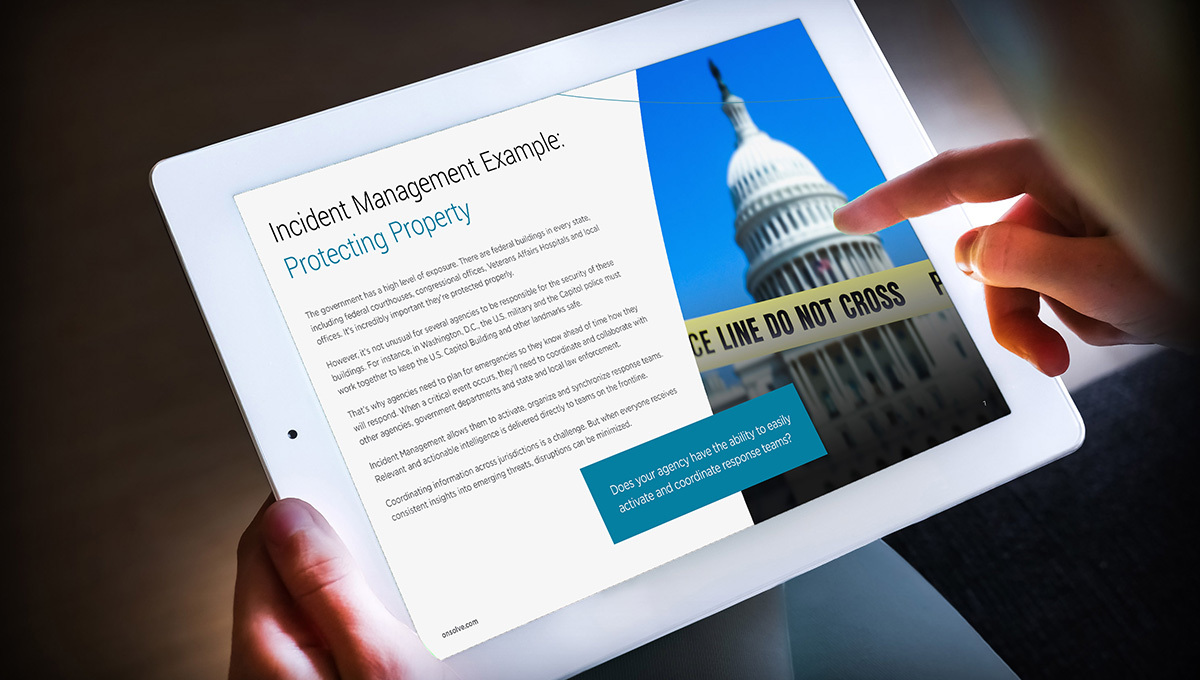Modern times have given us many innovations and advances that make life easier. The Internet of Things and social media keep us connected to friends and family across the globe. We can shop for just about anything we can imagine, and in just a few clicks, it appears on our doorstep.
But there’s another side of modern life that’s filled with challenges we never dreamed we’d have to face. Any one of a seemingly endless list of critical event examples – civil unrest, extreme natural disasters, cyberattacks and a pandemic that changed the world overnight – can impact our daily lives without warning.
In times like these, citizens are more reliant than ever on federal, state and local government agencies for protection. The increasing frequency and complexity of critical events mean agencies have an imperative to rise to the occasion and seek a more effective way to respond when crises occur so they can protect people, places and property. This can be accomplished through the use of effective critical event management solutions.
5 reasons NOW is the time to gear up for critical event management:
- The rising threat at home – Domestic terrorism and civil unrest are on the rise within the United States. According to a new report¹, protests skyrocketed in 2020 and still slightly increased from 2020 to 2021 (+4%). How can federal, state and local governments deal with the rising threat of militias and a growing political and racial divide within the country?
- More frequent and extreme natural disasters – In 2020 and 2021, there were more financially impacting ($B) natural events than any other year on record since 1980, according to NOAA. Extreme weather and natural disasters were up 47% in 2021. Floods, for example, are occurring in nontraditional areas—in Belgium, floods increased 420% from 2020 to 2021. Reports of blizzards (+197%) and avalanches (+202%) all tripled from 2020 to 2021, and tsunamis (+114%) more than doubled. How can agencies alert citizens early and keep them informed during and after such events?
- The rising threat online – Citizens and businesses are facing a tremendous increase in cyberattacks. And cybercrime has cost $18.7 billion over the past five years, including a record $6.9 billion in 2021 alone. What’s perhaps even scarier for citizens is who is being successfully targeted in these attacks. When hackers are able to penetrate the food supply, healthcare companies and gas pipelines, it’s normal to wonder what could be next. How can government agencies do a better job of detecting cyberattacks and keeping citizens and businesses informed of recovery updates?
- A global pandemic – The painful consequences of the pandemic are still evident. While we’re finally seeing some light at the end of the tunnel (and the face behind the mask), COVID-19 isn’t going anywhere. How can agencies keep constituents informed of vital information and deal with the enormous tasks of providing vaccinations and boosters for the population and reporting on new variants and outbreaks?
- An increasing complex web of critical event examples – Perhaps the most challenging aspect of the increased frequency and extremity of the above-mentioned events is the fact that government agencies often have to deal with multiple crises simultaneously. Extreme weather events, cyberattacks and issues of domestic extremism all occurred while we continue to recover from the pandemic. How can agencies at all levels respond to multiple events effectively and in a timely manner?
Three critical event management capabilities agencies need in their defense arsenal:
Properly managing and responding to more frequent and complicated critical events is a daunting task. Agencies need to arm themselves with three capabilities to ensure the safety of people, places and property.
- Accurate and relevant information about whether a critical event is happening or may happen in the near future. There’s a ton of data out there, so agencies need a way to sort through it quickly. Artificial intelligence (AI) delivers timely, relevant data so agencies can make well-informed, proactive decisions to protect against extreme weather events, civil unrest and cyberattacks.
- A detailed plan or checklist of how to respond. You can’t act quickly if you don’t already have a plan in place. In addition, everyone involved in the response effort needs to be notified immediately and have a way to communicate with others in real time. Extreme weather events are a classic example of when agencies need to modify their response plan based on the location, severity and duration of the event. Real-time communications and collaboration are essential.
- A reliable and effective means of communicating with all stakeholders. First responders, agency staff members and impacted citizens need to know what’s happening, what they should be doing and what others are doing to keep them safe. Alerts should only be delivered to impacted individuals and through a variety of communications channels. During the pandemic, for example, agencies need to alert citizens when they’re eligible for the vaccine or booster, send appointment reminders and notify nearby people if any last-minute appointments are available.
One last point: It’s not enough to have each of these capabilities at your disposal. You need a unified platform built for critical event management so you don’t lose precious time transitioning between disconnected systems. A reliable, responsive and modern critical event management platform arms agencies at all levels of government with the capabilities required to fight back against terrorism, wildfires, hurricanes, ransomware and, yes, even a global pandemic.
Want to learn how you can transform your agency’s crisis management capabilities? Download our playbook today.
¹CEO Brief: Global Risk Impact Report, August 2022


